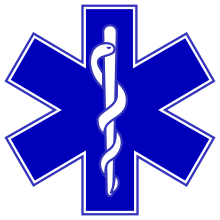Emergency medical services in the Netherlands
Emergency medical services in the Netherlands is a system of pre hospital care provided by the government in partnership with private companies.
Organization

Land Ambulance
Emergency medical service in the Netherlands is provided by a number of private carriers, operating under contract to the Dutch government. The system consists of a number of private ambulance companies, each with its own designated service area within one of fifteen service delivery regions, and with standards of operation that are provided by the government contract. All contracts stipulate that the contractor is required to meet all standards published for vehicles, equipment, training, and performance by the Dutch Ambulance Institute.[1] All contracts for EMS in the Netherlands are sent to tender every four years, with the contract being awarded to the most successful applicants. Netherlands law forbids EMS systems to earn any profit; any surplus revenue is required to be directed to additional improvements to the system, including training, equipment, and vehicles. The Dutch system is a rare exception to the rule in Europe, in that it operates on a variation of the Anglo-American model of EMS care,[2] and not on the Franco-German model,[3] followed by the majority of European countries.

Air Ambulance
The government of the Netherlands contracts for
Standards

Training
Since 1992, Dutch law has mandated at least one nurse on every ambulance in the country, at all times.
Staffing
All ambulances are staffed by a crew of two. These include one nurse, with the training and skill set described above, and one dedicated driver. The medical training of the driver is minimal, and that individual is minimal permitted to participate in patient care with assisting the nurse.[9] Mobile medical teams (MMT) are generally staffed by a surgeon or anesthesiologist with additional training to function in the prehospital environment and additional nurses. MMT aircraft are designed for team delivery, not medical transport. Transport is usually accomplished by means of the ambulance that originated the call, with the team on board. In case of weather that restricts flight operations, each MMT is also equipped with a special van for land response.
Vehicles

The Netherlands government mandates that all ambulances must meet the standards outlined by the Netherlands Ambulance Institute, in addition to the
Dispatch

All 25 EMS regions in the Netherlands are self-dispatching. Some regions have more than one centre, but all are interconnected. The technologies involved in the dispatch of EMS resources are generally equivalent to the American and British standards. All EMS dispatch centers participate in the national emergency number scheme. The emergency telephone number for ambulances in the Netherlands is 112. All EMS calls in the Netherlands are nurse-triaged.[11] Triage is conducted using national evidence-based triage protocols and guidelines developed by the Dutch Ambulance Institute. Most dispatch centers use computer-based decision-support systems.[12] As a result of this approximately 30 percent of all requests for service are dealt with by some other means of service at the scene, and in approximately 40 percent of cases, the call is triaged with a result that an ambulance response is avoided entirely.[13]
Response time
Dutch law provides support for all standards published by the Netherlands Ambulance Institute, which currently mandates that an ambulance must be in place on the scene of any emergency in the country within 15 minutes. That standard is currently being met approximately 95 percent of the time.[14]
See also
- Healthcare in the Netherlands
- Emergency medical services
- Emergency nursing
- International Red Cross and Red Crescent Movement
References
- ^ "Dutch Ambulane Institute website (in Dutch)". Archived from the original on 2007-09-29. Retrieved 2008-09-22.
- ^ Cooke MW, Bridge P, Wilson S (2001). "Variation in emergency ambulance dispatch in Western Europe". The Scandinavian Journal of Trauma and Emergency Medicine. 9 (2): 57–66.
- S2CID 31020961.
- ^ "University of Groningen Mobile Medical Team". Archived from the original on 2008-06-01. Retrieved 2008-09-22.
- ^ "AmbulanceZorg Nederlands website (english)". Archived from the original on October 3, 2008. Retrieved 2008-09-24.
- ^ Wulterkens D (2005-12-06). "EMS in the Netherlands: A Dutch Treat?". Journal of Emergency Medical Services. Archived from the original on February 4, 2009.
- ISBN 0-7872-7071-7.
- ^ "Ambulancezorg Nederlands website". Archived from the original on September 16, 2007. Retrieved 2008-09-24.
- ^ Wulterkens D (2005-12-06). "EMS in the Netherlands: A Dutch Treat?". Journal of Emergency Medical Services. Archived from the original on February 4, 2009.
- ^ "European Committee for Standards website". Retrieved 2008-09-19.,
- ISBN 0-7872-7071-7.
- PMID 17102200.
- PMID 16434351.
- ^ Wulterkens D (2005-12-06). "EMS in the Netherlands: A Dutch Treat?". Journal of Emergency Medical Services. Archived from the original on February 4, 2009.
